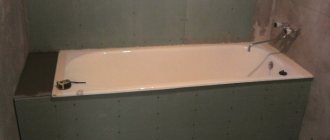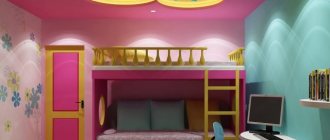Tatiana Vasilyeva
Interior designer in .
Repairing and furnishing a room for a child is more difficult than for an adult. There are many things to consider: eco-friendly materials, safe sockets, proper lighting, color schemes, and furniture that can grow.
The Lifehacker Telegram channel contains only the best texts about technology, relationships, sports, cinema and much more. Subscribe!
Our Pinterest contains only the best texts about relationships, sports, cinema, health and much more. Subscribe!
When renovating a nursery, we recommend adhering to two main principles - practicality and safety. The first is due to the fact that children grow quickly: a two-year-old and a five-year-old have different activities and needs. And in the children's room, something constantly falls, spills, and gets dirty. Drawings appear on the walls every now and then. Therefore, finishing materials should be durable and easy to clean, colors and patterns should be neutral, and furniture should be designed for the growth of a child.
The principle of safety is also very important because young children actively explore the world. They crawl, fall, try to open cabinets and are interested in sockets. Therefore, it is necessary to remove sockets from the access area and close them with plugs, avoid sharp corners and too hard materials on the floor. And also make sure that furniture and decoration do not release harmful substances into the air.
Use environmentally friendly and practical finishing materials
Paint on the walls and ceiling is a good choice, but carpet on the floor is debatable.
Photo: Sidekix Media / Unsplash Materials in the nursery must be safe: do not emit harmful substances, do not accumulate dust, do not provoke injuries.
Floor
Cork is ideal for the floor in a nursery: it is environmentally friendly and soft. Other options are parquet, parquet or engineered wood, laminate, vinyl tile, linoleum.
If you buy an artificial material - laminate, quartz vinyl, linoleum - find out whether it emits harmful substances. You can find a formaldehyde emission label on the packaging - class E1 is suitable for children. But low-quality material can be easily identified without it - by its pungent chemical smell.
Tiles and porcelain stoneware are not installed in children's rooms - they are too hard. If a child falls, he will suffer a painful blow or even be injured. Carpet is also a controversial option: it is soft, but collects a lot of dust.
Walls
For walls in a nursery, paper wallpaper and water-based paint are best suited. They do not emit harmful substances and allow air to pass through - the room will have a comfortable microclimate.
We do not recommend embossed non-woven wallpaper - dust accumulates on them. And small children also like to pick out relief elements, so the finish will quickly lose its appearance.
Ceiling
Plaster and water-based paint are ideal for a nursery: both materials are environmentally friendly, and the appearance of the ceiling will be easy to refresh.
If you want a suspended ceiling, choose a fabric one: it is more environmentally friendly than PVC. The advantage of this option is the ability to order canvas with photo printing. When the child gets tired of the picture on top, it can be replaced.
The most popular ways to decorate a children's room
Wallpaper
If earlier these elements, due to not so many variations, were almost standard means of decoration in all rooms, then today things are different. But still, practically no finishing material can compare with wallpaper in terms of ease of application to walls.
Today, the breadth of choice in the case of wallpaper is simply colossal, and these finishing products can be represented not only by standard paper, but also by washable, fabric and other options, even liquid wallpaper. Not to mention photo wallpapers, which at the moment you can not only buy in ready-made versions, but also create yourself, based on your images. When choosing wallpaper, experts advise considering several factors:
- Many experts advise using paper wallpaper for its high environmental friendliness. Moreover, such wallpapers are also affordable, so replacing them should not be a problem. There are washable paper-based wallpapers, which will make it easier to wipe off children’s drawings and other dirt;
- When using fabric wallpaper, you should use only options with impregnation that reduces the degree of dust. One of the principles of decorating a children's room is to prevent accumulations of dust that causes allergies and other negative processes;
- Cork wallpaper. It is worth considering this material, which can give walls softness and is also completely environmentally friendly. The disadvantages include an insufficient variety of colors and textures - finishing in this way may seem too boring to a child;
- Use paintable wallpaper. In this case, the walls are finished with special materials that allow the paint to adhere as efficiently as possible. The advantage of such wallpaper is that, if necessary, they can be repainted quite simply, which is very convenient.
Painting
Also a very popular way to decorate walls. Everyone is more or less familiar with the process of applying paint, as in the case of wallpaper, so such repairs can be done independently. Painting is also attractive because with its help you can not only give the walls the desired color and zone the room, but also paint. If necessary and skillful, you can draw on the walls much of what the child will like, but this process is very labor-intensive.
As for the choice of paint, it is better to choose water-dispersion options due to their high environmental friendliness, lack of unpleasant odor, quick drying and ease of use. We described all the advantages of such paint in one of the previous articles.
At the same time, compositions specifically designed for painting children's rooms are sold on the market today. Most often these are water-soluble acrylate paints, which, in addition to all the above advantages, also allow the walls to be easily washed, which is very important. As an alternative, you can also consider paints with silver ions, which have a bactericidal effect.
Another advantage of paint is that if scratches or chips appear on the wall, they can be easily covered up. With wallpaper, such simplicity is not available.
Important! Chalkboard paint is a great way to finish a wall to give it a chalkboard effect. Moreover, such paint does not have to be dark at all, since you can give it any look, including making it yourself. We devoted a separate article to this finishing method on our website. The main advantage is that you can draw on a wall finished in this way with chalk, after which you can easily erase what you have drawn. This way, you will satisfy your baby's craving for creativity without damaging the walls.
Plaster
One of the most popular methods of wall decoration is applicable in the case of a children's room. In this case, plaster can be ordinary or decorative, characterized by a large number of variations. The advantages of this approach are the following:
- Numerous finish variations, the use of which depends only on your preferences and financial capabilities;
- Alignment of walls. This is relevant for secondary housing and many new buildings - the walls here are quite rarely perfectly smooth, and plaster can eliminate this drawback;
- Environmentally friendly. The plaster is produced on the basis of environmentally friendly natural components, and the solvent for it is plain water;
- Durability of the material. If you want to use the children's room for a grown-up child, then plaster will allow you to avoid making repairs for as long as possible.
The disadvantage is traditionally the difficulty of care. It is quite difficult to wipe off dirt and drawings from such walls. The situation is solved by using a special varnish that creates a protective layer on the wall that is suitable for washing. The only thing that is important when selecting is to choose a composition based on environmental friendliness.
Other ways to decorate walls in a nursery
- There are special coloring wallpapers made in the form of outlines that a child can color in independently. Naturally, it is better to decorate not the entire room with such wallpaper, but only part of it, while trying not to raise it above the height of the child;
- Vinyl stickers. In this case, the decor can be changed as quickly as possible, adding new elements in accordance with the changing tastes of the growing child, or removing them completely. This category also includes figures based on polystyrene foam or polyurethane foam;
- Fabric wall decoration. We also previously devoted an article to this finishing method on our website. The walls are warm and soft, and small unevenness on them can be effectively hidden. But fabric is not the most practical material - it is easily soiled and collects dust.
Make sure there is good ventilation
Valves can be installed on the windows to provide constant fresh air.
Photo: Okfil To prevent the air in the nursery from stagnating, pay special attention to airing and ventilation.
Windows with micro-ventilation are ideal. They will provide a constant flow of fresh air without drafts.
It is also worth thinking about supply ventilation - this is a system that provides air flow from the street. There is no need to open the windows.
Installed breather. Photo: Wetrolink
For supply ventilation, different devices are used: valves, mechanical ventilators and breathers. The last option is the most complex and expensive. It is ideal for allergy sufferers: breathers are equipped with filters that filter out pollen and street dust.
For decoration, choose calm colors and simple patterns.
Polka dot walls are neutral without being boring.
Photo: Victoria_Borodinova / Pixabay To decorate a children's room, it is better to choose calm and muted shades: white, gray, beige, light green, peach. They will not irritate the child and will remain relevant even when he grows up.
We do not recommend sticking colorful wallpapers with cartoon characters: they quickly become boring. This option is especially bad if the child is 4–5 years old. Soon he will go to school, his tastes will change, and it is quite difficult to concentrate in a room with bright decorations.
If you want to stick wallpaper with a pattern or draw something on the wall, consider options that will be appropriate for 5-6 years - until the next cosmetic renovation. Walls with polka dots and stripes, with plant motifs, look beautiful.
In general, when decorating a nursery, it is important to provide the ability to change the room to suit the needs of a growing child. This will help create a basic interior and avoid large-scale alterations every 3-4 years.
Wall requirements
The following conditions apply to the walls of the children's room:
- materials of the supporting structure and finishing must be completely harmless to the health of the child and environmentally friendly;
- walls simply must be strong. There should not be situations where a child running at speed breaks through a partition with his body;
- the colors used to paint the walls of the child’s room should be neutral.
Provide space for creativity
Chalkboard paint is more expensive than regular paint, but you can draw on it with crayons.
Photo: photographee.eu / Depositphotos If the child is small, when renovating the nursery, it is worth considering that he will probably draw on the walls. There are two options: choose a cheaper finish or leave a special place for painting.
So that the child can draw on the entire surface of the walls, paint them with water-based paint or cover them with paper wallpaper. These are safe and relatively inexpensive materials. When the child outgrows drawing on the walls, they can be repainted or re-pasted.
If you want to allocate space for creativity on the walls, take a closer look at marker or slate paint. On such a surface you can use markers and crayons, and then easily erase what you have drawn. But this option is suitable for children from 3–4 years old: it is difficult to explain to a very small child that they cannot draw on the rest of the walls.
For girls
The following tones will be preferable as a background:
Note!
Children's room for a schoolchild: 120 photos and video description of how to choose a stylish and functional design for the room
Bed for a children's room - 165 photos and video description of how to choose the right bed
Carpet for a children's room - 155 photos of options for insulating a child's room using carpets
- pale blue;
- light yellow;
- pink;
- lilac.
It is preferable to place elegant stickers and drawings with your favorite characters on the walls. The girl’s own handicrafts can also be displayed.
A children's room is an important place in a child's life. Its design should contribute to the development of the child and should be approached responsibly.
Consider zoning for growth
The bed in the children's room is separated from the chair by a shelving unit.
Photo: Victoria_Borodinova / Pixabay In the nursery, the child sleeps, plays, studies, and receives guests. Therefore, it is necessary to highlight functional zones here. The arrangement of furniture, the location of lamps, sockets and switches depend on them.
Basic functional areas in the nursery:
- for sleeping, relaxing and receiving guests;
- for games and sports;
- for studying.
It is not necessary to separate zones with partitions or shelving. To do this, you can use the color of the walls, rugs, or simply provide the necessary furniture.
You need to think about zoning before renovation, because each zone should have its own lighting, sockets, furniture, and sometimes decoration. Therefore, the first thing you need to do on the room plan is to place the furniture.
It is also important to think about the functionality of the room for growth. A 3-year-old child does not need a work area, but a 7-year-old will need one. It is important that where the desktop will be located in the future, there are sockets for a computer and a table lamp. It will be difficult to carry them out after the renovation: you will have to remove the finishing touches and trench the walls.
Provide adequate lighting
This nursery has general lighting on the ceiling, a task light at the table, and a lamp near the bed.
Photo: svetlanafeo / Depositphotos In the nursery, you need to provide general lighting - a large lamp in the center of the ceiling or several built-in ones - and working lighting in each functional area.
Near the bed or sofa you need a night light or wall lamp, and near the desk - a socket for a table lamp. It is not necessary to install separate lighting in the play area, but it is also worth placing a lamp socket nearby in case the child decides to draw or sculpt.
It is better to choose lamps for general and task lighting with neutral light. A warm one is suitable for a night light - it relaxes and sets the mood for rest. It is better not to use cold lamps in the nursery: such light is invigorating, but over time it begins to irritate.
Electrics and lighting in the children's room
There should be enough light in the children's room. It is better to give preference to natural light. But if access to sunlight is limited for some reason, then it is necessary to properly organize artificial lighting, since the quality of light and its quantity can affect the child’s condition, his development and even psycho-emotional health.
Bright lighting around the perimeter of the children's room
Many experts recommend determining from the very beginning of the general renovation of the apartment exactly where the children's room will be located. It is believed that the ideal option would be a room with windows facing southeast.
If the windows face east, then it is worth purchasing light tulle, which will slightly muffle the too bright natural morning light.
The child should have several light sources in his room. The main one is the central lamp. It is advisable that he have several small or one fairly powerful light bulb.
For a child’s room, you should not choose energy-saving light bulbs that are fashionable these days - they can harm children’s vision. It is better to buy ordinary incandescent lamps.
Creative solution for central room lighting
As an addition, you can use modern spotlights that will illuminate any, even the farthest corner of the room.
Universal ceiling spots
When designing a study area in a children's room, you should distribute the lighting so that the light contributes to a comfortable pastime and does not overstrain the eyes.
Proper illumination of the child’s work area
For these purposes, you can buy table lamps, floor lamps or spotlights. Lighting should never be directed directly into the eyes or create a shadow on the work surface.
If necessary, you can add additional lighting near the bed. Most often, bedside lamps or not very powerful floor lamps are placed there.
Make sure the light source is moderately bright. If it shines too much, it will damage your eyesight. Lights that are too dim can create shadows that may frighten a small child.
Night light for a children's room with a moderate glow
After installing the lighting devices, it is necessary to check the serviceability of the electrical wiring and ensure the quality of the insulation. All wires should be hidden or hidden, and special protection can be purchased for outlets.
Take care of safe electrical
In children, there should be sockets in every functional area. In a room for a 5-6 year old child they are needed to connect a lamp or a humidifier. The student will need sockets for a computer, printer, and smartphone charging.
The sockets in the baby’s room should have plugs so that he cannot connect any electrical appliance himself or check the voltage with a hairpin. You can install sockets higher so that the child cannot reach them.
But the switches must be installed so that the owner of the room can turn on and off the lighting himself.
Colors in the nursery interior
Neutral, soothing colors should predominate. These include:
- grey. It is an excellent basis for applying other decorative elements and at the same time emphasizes the laconicism of the design;
- yellow. People associate it with the sun, warmth, joy and positivity;
- green. Gives the room a certain depth and is very pleasing to the eye;
- lilac. Gives the atmosphere in the room even more comfort, and its inhabitants a desire for creative self-development;
- pink. This color is more suitable for teenage girls' rooms. It carries within itself the tenderness, warmth and fabulousness they need;
- white. Gives the interior a feeling of spaciousness, freedom, fills it with purity and naturalness;
- beige. Gives a feeling of comfort and is suitable for a child of any age and gender.
Buy functional furniture
Laconic furniture will last a child for several years.
Photo: Victoria_Borodinova / Pixabay To save money, it is better to buy furniture for the nursery “for growth.” Models of calm colors and shapes are suitable. A child will outgrow a car bed in a couple of years, but a regular one will last until adolescence or even longer.
It is better not to buy furniture with sharp corners for a small child’s room. If you still had to put a square table or chest of drawers with a rectangular lid there, install special covers on the corners.
For small rooms for children aged 7–10 years, multifunctional furniture is suitable: a loft bed with a work desk under the bed or even a structure with a wardrobe bed. These options will save space and provide different scenarios for using the room.
All cabinet furniture in the children's room should be attached to the wall so that it cannot be accidentally knocked over.
No. 3. Decorative plaster
Plaster is also often used in children's rooms, since it meets the basic requirements for this room. Among its advantages it is worth noting:
- unique appearance, since it will be impossible to repeat the resulting relief pattern;
- environmental friendliness and health safety;
- the ability to hide small imperfections in the walls;
- solidity of the finished coating;
- if you have minimal experience, you can cope with applying plaster yourself;
- durability.
To give the plaster layer additional stability, you can cover the walls with a layer of transparent varnish . In this case, it will be much easier to clean the walls from the effects of children’s games, and the coating will be even more durable. True, you will also need to choose the varnish composition with great attention, since it must be as safe as possible for health.
Create convenient storage
It is convenient to take toys from a low rack.
Photo: Paige Cody / Unsplash Storage in the nursery should be organized so that the owner of the room can take the necessary toy or book at any time. Therefore, when arranging a room for a child 2–6 years old, it is better to give preference to low shelves with boxes and baskets rather than cabinets - this way everything will be visible.
School-age children will need space for textbooks and office supplies. It’s good to place them in your workspace: install racks and cabinets, hang shelves, buy a desk with compartments.
Regular closets and chests of drawers are suitable for storing clothes and shoes. When choosing, you should not focus on children’s height: parents help the baby get dressed, and a teenager will be comfortable using standard furniture.
Vinyl Wall Stickers
The only disadvantage of this design is that sooner or later any decor gets boring. The eye becomes blurred, and the magnificent plot ceases to attract attention. And children grow very quickly, and with age their tastes and preferences change.
Artistic painting is a rather expensive process, but you can save a lot by using wall stickers in the interior of a children's room.
The choice of vinyl stickers is growing every year; you can choose both stylish options in one color and bright colored elements. Even decorating an entire wall will not take much time, and small elements can be glued together with the children - they will enjoy this interesting and exciting activity.
Stickers can be changed to others, decorating the room for each holiday or changing the decor in accordance with the changing seasons.
Add textiles for comfort
Optimal for a nursery: Roman blinds, short-pile carpet, bedspreads and pillows.
Pixabay Textiles in a children's room should be safe and easy to care for.
You should not hang floor-length curtains in rooms for children under 5 years old: a child can grab onto them and tear them off the curtain rod. A safer and more practical option is Roman blinds: when unfolded, they barely cover the window sill.
Carpets in a children's room are placed next to the bed, in the play area, and under the work chair. It is better to choose models with short pile or no pile at all: they collect less dust and are easier to care for than long-pile carpets.
If a child is allergic to dust, the amount of textiles in the room will have to be reduced: curtains should be replaced with blinds, sofa cushions removed, and blankets stored in the closet. You should also avoid natural fillers in pillows and blankets and wool products.
Which finish is suitable for walls in a nursery?
The main requirements for finishing materials for children's rooms:
- absence of harmful impurities – materials without toxic substances;
- fire safety - the finish does not support combustion;
- breathability - the material breathes;
- easy replaceability - small children can easily ruin the coating, and older children may get tired of the drawings “for little ones”;
- visual hygiene.
Images on the walls should not be aggressive or cause emotional overload (this is not only a playroom, but also a bedroom, place of study). At the same time, their task is to develop the child’s good taste and awaken positive emotions in him.
Listen to the opinion of psychologists about the impact of color and ornament on the nervous system.
There are two main finishing methods that are suitable for a children's room - paint and wallpaper. We do not consider another type - plaster, since its texture can injure a child during games, and it is quite difficult to correct a damaged part (for example, if it has been painted on or picked apart).
5 myths about wallpaper that it’s time to dispel
Wallpaper and a bathroom are mutually exclusive concepts, in the kitchen wallpaper will have to be washed aggressively, paper wallpaper will certainly absorb all odors, vinyl wallpaper will emit substances harmful to health, and in progressive foreign interiors wallpaper has become extinct as a species. None of this is true.
What to remember
- Keep in mind that your child's needs will change quickly. Consider the location of furniture, sockets and lamps based on a 4-5 year perspective.
- Choose easy-to-care and environmentally friendly finishing materials. Cork, parquet, laminate, linoleum, quartz vinyl are suitable for the floor. For the walls - paint and paper wallpaper. For the ceiling - paint or stretch fabric.
- Don’t buy expensive wallpaper or paint for small children’s rooms—the walls will definitely be painted. Limit yourself to water-based or cheap paper wallpaper. If the child is already able to understand where it is possible to draw and where it is not, paint part of the wall with chalkboard or marker paint.
- Choose calm colors and universal patterns to decorate the room - they will remain relevant for the child longer.
- Select functional areas for relaxation, games and study. For each zone, consider lighting and install sockets.
- Take care of safety: buy sockets with plugs and furniture with rounded corners. Avoid long curtains. Secure cabinet furniture to the walls.
- Use multifunctional furniture and transformable items for small rooms.
- Please note that the owner of the room is the child himself. Install switches at a comfortable height, organize a storage system convenient for the child’s occupant, and involve him in decorating the space.
No. 2. Chalkboard and magnetic paint
Although these types of finishing materials belong to the type of paints, I would like to pay special attention to them. Chalkboard paint is a real godsend for children's rooms, because many parents are familiar with the situation when children paint freshly hung wallpaper with felt-tip pens and pencils. To give your child complete freedom of creativity and to protect other parts of the apartment from the appearance of drawings, you can paint one of the walls in the nursery or part of it with slate paint. With its help, you can turn any selected part of the wall into something like a school board: drawings can be erased, new ones can be applied, and with their help you can create a unique interior.
Slate paint is odorless and is approved for use in children's rooms. It's easy to apply, suitable for almost any surface, and the chalk won't leave scratches. The result is an excellent space for the child’s self-expression and play. Once again, it is worth noting that there is no need to paint all the walls in the nursery with slate paint, otherwise the result will not be an interesting interior, but a boring space.
Magnetic paint is a relatively new coating on the building materials market. It can be used in the work area and painted part of the wall near the table. After applying and drying the paint, the surface becomes magnetic, and you can use small magnets to attach your child’s drawings, some notes or reminders, organizing the space in an interesting way. To produce magnetic paint, a water base, metal powder and binding elements are used; the material is odorless. True, reviews from those who have already used this material indicate that it is better to use smaller and stronger magnets, which means that such finishing is better used to decorate the room of an older child, and not a preschooler who can swallow a small magnet.











